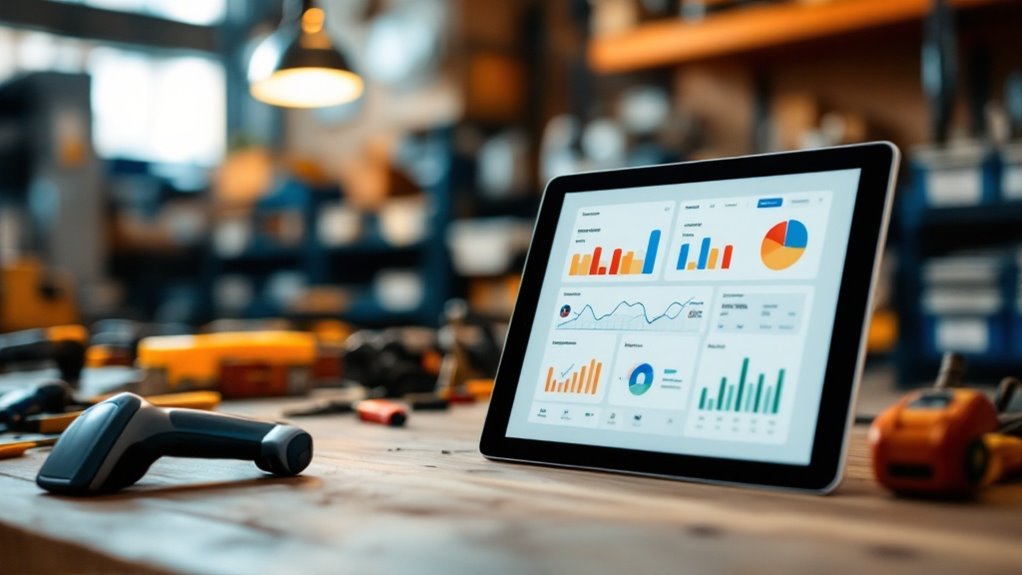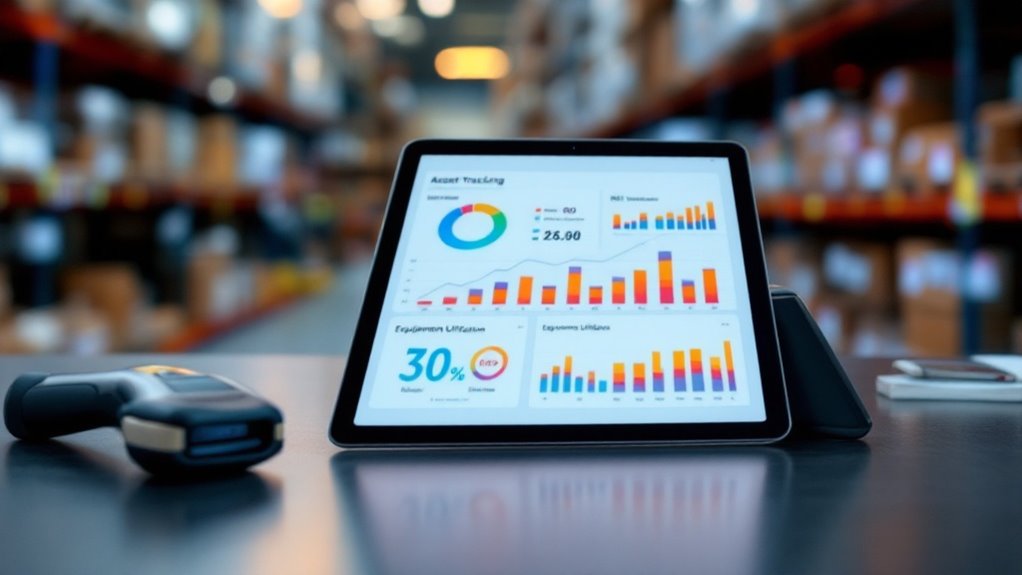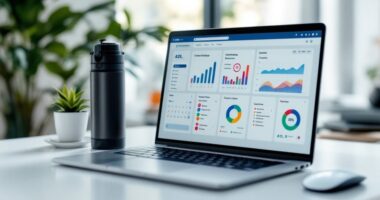Asset tracking software helps small businesses monitor and manage their valuable equipment, inventory, and resources through automated digital systems. These solutions offer real-time visibility, prevent losses, and extend asset lifespans through scheduled maintenance alerts. Popular budget-friendly options include Itemit’s free Personal plan for up to 500 assets and EZO Office Inventory starting at £31/month. Modern systems boost efficiency with mobile access, barcode scanning, and cloud storage capabilities. Small businesses implementing asset tracking typically see up to 95% reduction in losses and 30% longer equipment life – benefits that become clear when examining the complete ROI picture.
Quick Overview
- Asset tracking software provides real-time visibility of equipment location and usage, preventing losses and unauthorized use in small businesses.
- Budget-friendly solutions like Itemit’s free Personal plan support up to 500 assets with barcode scanning and mobile access.
- Implementation reduces asset losses by 95% while increasing equipment lifespan by 20-30% through better maintenance scheduling.
- Cloud-based systems offer mobile accessibility, basic reporting tools, and integration with existing business systems for seamless operations.
- Small businesses can track assets using GPS, RFID, or QR codes while maintaining centralized databases for detailed information.
Why Small Businesses Need Asset Tracking Software

Small businesses face increasing pressure to maximize efficiency and minimize waste in today’s competitive marketplace. Asset tracking software provides essential tools that help companies stay organized while boosting their bottom line.
These systems deliver real-time visibility into asset location and usage, preventing costly losses and unnecessary purchases. By automating data capture and maintenance scheduling, businesses can extend equipment lifespan and reduce unexpected downtimes. The software also strengthens accountability through check-in/out functions and movement tracking, deterring theft and unauthorized use. Systematic processes through RFID and barcode scanning enable accurate digital data collection.
For growing companies, asset tracking solutions offer scalability without requiring system overhauls. Cloud-based platforms guarantee accessibility while integrating smoothly with existing business systems. With features like automated inventory management and accurate depreciation tracking, small businesses can make data-driven decisions that optimize their operations and enhance profitability.
Essential Features for Small Business Asset Management
When selecting asset management software, businesses need to focus on key capabilities that will directly impact their operational efficiency. Small businesses should prioritize features that offer immediate value while remaining cost-effective and easy to implement.
Smart asset management starts with choosing software that delivers real value without compromising budget or ease of use.
The most essential features for small business asset tracking include:
- Real-time tracking capabilities through GPS, RFID, or QR codes for accurate asset location
- A centralized database that stores detailed asset information and maintenance records
- Mobile accessibility with cloud-based solutions for managing assets on-the-go
- Basic reporting tools to analyze asset utilization and performance
These core features provide the foundation for effective asset management while maintaining simplicity. The software should be intuitive enough for staff to learn quickly yet robust enough to grow with the business. Similar to quality management systems, asset tracking software can help businesses achieve compliance with regulatory standards and improve operational efficiency. Integration with existing business systems and the ability to work offline guarantee continuous operation regardless of connectivity issues. Setting up customizable alerts for maintenance schedules and inventory levels can help prevent equipment downtime and stockouts.
Top Budget-Friendly Asset Tracking Solutions

Budget-conscious businesses can now choose from several cost-effective asset tracking solutions that deliver professional-grade features without breaking the bank.
For companies managing up to 500 assets, Itemit’s free Personal plan offers an excellent starting point with barcode scanning capabilities and mobile access. EZO Office Inventory provides an affordable option at £31/month, ideal for businesses tracking over 250 assets. Small operations seeking exhaustive features might consider AssetTrac, which includes unlimited assets and lifetime support in its package.
For businesses needing maximum value, Timly stands out with its reported 500% ROI and rapid 24-hour implementation. Asset Panda offers flexibility with customizable fields and pricing based on asset count, making it suitable for growing businesses that need scalability without significant upfront costs. Solutions like Snipe-IT provide robust open-source asset management capabilities that help reduce operational costs while maintaining essential tracking features.
Getting Started: Implementation Steps for Success
Through careful planning and systematic execution, implementing an asset tracking system can transform chaotic inventory management into a streamlined operation. The process begins with a thorough assessment of current needs and selecting suitable software that fits the business’s specific requirements. Real-time insights enable businesses to instantly locate and monitor assets throughout their lifecycle.
Effective asset tracking transforms disorder into efficiency through strategic planning and the right technological solutions.
Key implementation steps include:
- Conducting a complete inventory audit of existing assets
- Setting up proper tagging systems with durable labels or RFID tags
- Creating an extensive asset database with detailed records
- Training staff thoroughly on new procedures and protocols
Success depends on proper setup and consistent follow-through. The implementation team should establish clear workflows for asset assignments, transfers, and maintenance scheduling. Regular system audits help verify accuracy, while ongoing staff training maintains proper usage. With these fundamentals in place, small businesses can effectively track and manage their valuable assets.
Maximizing ROI With Asset Tracking Software

Small businesses can dramatically boost their return on investment by implementing exhaustive asset tracking software solutions. When properly utilized, these systems can reduce asset losses by up to 95% while increasing asset lifespan by 20-30% through better maintenance scheduling. Implementing preventive maintenance schedules helps businesses avoid costly equipment failures and extend operational lifespans of critical assets.
Key ROI benefits include:
- 80% reduction in time spent searching for equipment
- Optimized asset utilization rates of 20-30%
- Lower maintenance costs through predictive scheduling
- Enhanced accuracy in financial reporting
To maximize returns, businesses should:
- Centralize all asset data for improved visibility
- Automate tracking processes to eliminate manual errors
- Implement real-time monitoring systems
- Integrate tracking with existing business software
- Use data analytics to identify underutilized assets and optimize resource allocation
These improvements lead to substantial cost savings while ensuring better compliance and risk management.
Real-World Success Stories From Small Business Owners
Real business owners across diverse industries have documented remarkable transformations after implementing asset tracking solutions. YouthBuild Philly streamlined their reporting processes, while Hockinson School District modernized their outdated tracking system. The results speak for themselves:
Asset tracking solutions have revolutionized operations across industries, helping organizations streamline processes and modernize outdated systems with proven results.
- ACTS nonprofit now efficiently manages 8,000 assets through specialized software
- A Fortune 100 tech company reduced inventory count time from 3 days to minutes
- One company slashed annual asset losses from $30,000 to just $1,500
- Grainger increased asset production to 56,000 without expanding their team
These success stories demonstrate how asset tracking software delivers tangible benefits for organizations of all sizes. Small businesses particularly benefit from automated workflows, real-time monitoring, and scalable solutions that grow alongside their operations. The combination of cost savings and operational efficiency makes asset tracking an invaluable investment. With comprehensive reporting capabilities, businesses can make data-driven decisions to optimize their asset management strategies.
Frequently Asked Questions
Can Asset Tracking Software Work Without an Internet Connection?
Asset tracking software can function effectively without an internet connection through offline modes. When offline, users can still scan barcodes, record asset data, and perform basic tracking functions.
The software stores information locally on devices until connectivity is restored, at which point it automatically synchronizes with the central database. While some advanced features may be limited offline, core tracking capabilities remain operational, making it practical for use in remote locations or areas with poor connectivity.
How Long Does Employee Training Typically Take for Asset Tracking Software?
Like a seedling growing into a strong tree, employee training for asset tracking software develops over time.
Basic software orientation typically takes 1-2 days, while thorough implementation requires 2-4 weeks. The exact duration depends on several factors, including software complexity and staff’s technical skills.
Most companies provide an initial 30-60 minute walkthrough, followed by structured training sessions. Ongoing support through mentorship and regular updates guarantees long-term success.
What Happens to Tracked Data if the Software Company Goes Bankrupt?
When a software company declares bankruptcy, tracked data typically becomes part of the bankruptcy estate. The bankruptcy court decides its fate, which can lead to several outcomes.
The data may be sold to another company, transferred to a new service provider, or potentially lost if not properly protected. Companies should safeguard against this by maintaining regular backups, reviewing service agreements, and considering data escrow solutions to promote business continuity regardless of the software provider’s status.
Are There Industry-Specific Templates Available for Different Types of Businesses?
Yes, industry-specific templates are readily available across various business sectors. Common examples include:
- Construction templates for equipment and material tracking
- Healthcare templates for medical device management
- IT equipment tracking spreadsheets
- Manufacturing asset management layouts
- Retail inventory templates
These templates come with customizable features like:
- Industry-specific fields
- Specialized compliance tracking
- Relevant reporting tools
- Integration capabilities with sector-specific software
- Custom status options
These pre-built solutions help businesses start tracking assets immediately without extensive setup time.
Can Multiple Locations Share the Same Asset Tracking System Simultaneously?
Unity is strength, and this principle applies perfectly to multi-site asset tracking. Organizations can indeed share a single tracking system across multiple locations simultaneously. The system maintains separate data for each site while allowing global administrators to oversee all locations.
Each site operates independently with its own administrators and users, yet benefits from centralized management. This approach reduces costs, streamlines operations, and provides real-time visibility across all locations.
Conclusion
Like a skilled conductor orchestrating every instrument in perfect harmony, asset tracking software brings order and efficiency to small business operations. By implementing the right solution, companies can transform chaotic asset management into a streamlined process that saves time and money. With proper planning, careful feature selection, and consistent use, small businesses can leverage these powerful tools to protect their investments and fuel sustainable growth for years to come.








